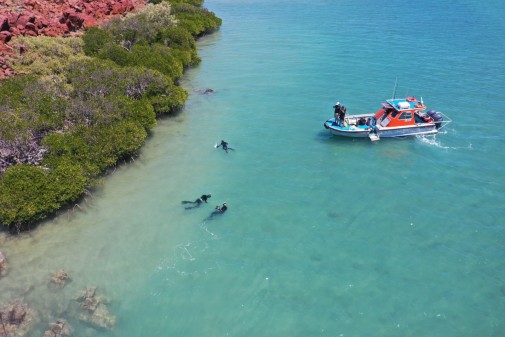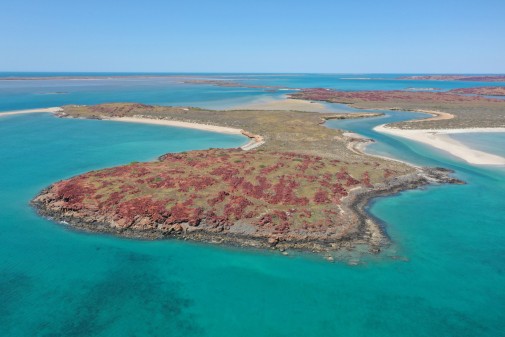Researchers discover lost ancient Aboriginal history beneath waves of Australia’s coast
Posted on 1 July 2020
 Archaeologists working in the shallow waters off Western Australia. credit: J. Leach, DHSC Project.
Archaeologists working in the shallow waters off Western Australia. credit: J. Leach, DHSC Project.
The finds were made off the Pilbara coast in the Dampier Archipelago of Western Australia and include stone tools and grinding stones.
The artefacts have remained undisturbed for thousands of years since they were first deposited on dry land and later inundated by sea level rise.
One site at Cape Bruguieres with 269 stone tools is 2.4 metres below modern sea levels and dates back at least 7,000 years. The second site in Flying Foam Passage is an underwater freshwater spring at 14 metres below current sea levels and dates back at least 8,500 years.
Sea Country
These submerged landscapes represent what is known today as Sea Country to many Indigenous Australians, who have a strong cultural, spiritual and historical connection to them.
Until these latest discoveries, archaeologists have remained sceptical that any trace of the ancient people that occupied these lands could have survived rising sea-levels.
The research team included archaeologists and geoscientists from the University of York, Flinders University, The University of Western Australia, James Cook University and Airborne Research Australia (ARA), in partnership with the Murujuga Aboriginal Corporation.
Twenty thousand years ago at the height of the last glaciation, sea level was 130 metres lower. The archaeological sites discovered in the study were originally located on the inner edge of a coastal plain that extended 160 kilometres offshore of the present coast of Western Australia.
Global challenge
Professor Geoff Bailey, from the Department of Archaeology at the University of York, Visiting Professor at Flinders University, and a partner investigator on the project and co-author said: “Investigation of these submerged landscapes is a global challenge. Over 20 million square kilometres of new territory were exposed by low sea levels across the world during the Last Glaciation and probably hide some of the most important evidence for human developments over the past 100,000 years. Yet we know rather less about these drowned human landscapes than we do about the surface of the Moon.
“The Australian discoveries are especially significant in a continent first colonised over 60,000 years ago by maritime people who crossed the sea from SE Asia, for whom coastal regions must have been a major focus of settlement and dispersal”
“These new finds also offer a rare example of site discovery achieved by purposeful survey based on a systematic combination of predictive modelling, airborne and underwater remote sensing and diver investigation, and a model for similar investigations in other parts of the world.”

Land and sea
Lead author and project director, Associate Professor Jonathan Benjamin of Flinders University, added: “This is an exciting step for Australian archaeology as we integrate maritime and Indigenous archaeology and draw connections between land and sea,”
“Australia is a massive continent, but few people realise that more than 30% of its land mass was drowned by sea-level rise after the last ice age. This means that a huge amount of the archaeological evidence documenting the lives of Aboriginal people is now under water.”
“Now we finally have the first proof that at least some of this archaeological evidence survived the process of sea level rise. The ancient coastal archaeology is not lost for good; we just haven’t found it yet.”
Further information:
Professor Geoff Bailey is Chair of the pan-European SPLASHCOS (Submerged Prehistoric Archaeology and Landscapes of the Continental Shelf) research network, funded by the EU COST Program. Over the past decade the network has promoted research, training, public outreach and collaboration with offshore industries and heritage organisations. The final SPLASHCOS volume was published by Springer in April as The Archaeology of Europe’s Drowned Landscapes, accompanied by the SPLASHCOS viewer, an interactive online database of over 2500 underwater sites.
Explore more news

Pharmacists could save the NHS billions of pounds with medicines checks, according to analysis by University of York
Monday 6 October 2025

University of York spin-out company receives funding boost
Monday 6 October 2025

Societal inequality linked to structural brain changes in children
Tuesday 30 September 2025

Cancer study to address ‘neglect’ of Gypsy, Traveller and Roma community
Tuesday 30 September 2025

Wolf protection downgrade highlights need for adaptive conservation frameworks, say experts
Thursday 18 September 2025
Media enquiries
About this research
Aboriginal artefacts on the continental shelf reveal ancient drowned cultural landscapes in northwest Australia is published in PLOS ONE. The Deep History of Sea Country Project is funded by the Australian Research Council through its Discovery Project Scheme.
Explore more of our research.
